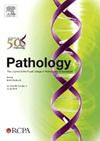Clinicopathological and molecular characteristics of paediatric-type follicular lymphoma: an analysis of 39 cases
IF 3
3区 医学
Q1 PATHOLOGY
引用次数: 0
Abstract
Our aim was to investigate the clinicopathological characteristics of paediatric-type follicular lymphoma (PTFL). The clinicopathological data were collected from 39 patients with PTFL diagnosed at the Department of Pathology, Ruijin Hospital, Shanghai Jiao Tong University School of Medicine, China, from January 2017 to September 2024, including the morphology, immunohistochemical (IHC) analysis, and Ig gene rearrangements detected by polymerase chain reaction (PCR). Fluorescence in situ hybridisation (FISH) was performed to detect breakages in BCL2, BCL6, MYC, and IRF4 genes. In situ hybridisation (ISH) was used to detect Epstein–Barr virus (EBV)-encoded small RNAs (EBERs). Follow-up data were obtained from all patients through telephone interviews and by checking the electronic medical record system. The study cohort comprised 39 PTFL patients, 34 males and five females, with a median age of 15 years (range 7–41 years). The primary clinical presentation was lymph node enlargement in the head and neck regions, without systemic symptoms such as fever, night sweats, or weight loss. All patients were staged as I or II. Of these, 34 patients were followed up, whilst five were lost to follow-up. The follow-up period extended from 3 to 89 months, with no recorded cases of disease progression or mortality. Histologically, the architecture of the lymph nodes was markedly altered by large, irregular follicular nodules, which were either confluent or back-to-back, and contained medium-sized, relatively uniform blastoid cells. Some cases exhibited a mix of cell types characteristic of high-grade classic follicular lymphoma. All cases exhibited prominent ‘starry-sky’ pattern in neoplastic germinal centres. Mantle zones were often thin or absent. Neoplastic follicles were immunoreactive for CD20, CD79α, BCL6, and CD10, but not for CD3 and CD5. BCL2 was not expressed except for a few atypical cells in Cases 15 and 27 showing weak BCL2 expression. MUM1 was negative, except in Cases 5 and 27, where tumour cells were MUM1 positive. C-MYC expression varied in 24 cases, and the Ki-67 proliferation index was elevated (40–90%). CD21 and CD23 highlighted the follicular dendritic cells, confirming the confinement of tumour cells to the follicles. Immunoglobulin D (IgD) staining revealed attenuated or discontinuous mantle zones. EBV ISH was positive in only one of 37 cases. PCR detected Ig gene rearrangements in 35 of 36 cases. FISH analyses revealed no translocations or rearrangements in BCL2, BCL6, IRF4, or MYC. Collectively, our findings provide a deeper understanding of the clinical, morphological, IHC, and molecular characteristics of PTFL, which portends a favourable prognosis, setting it apart from conventional follicular lymphoma.
小儿滤泡性淋巴瘤39例临床病理及分子特征分析。
我们的目的是探讨儿科型滤泡性淋巴瘤(PTFL)的临床病理特征。收集2017年1月至2024年9月在上海交通大学医学院附属瑞金医院病理科诊断的39例PTFL患者的临床病理资料,包括形态学、免疫组化(IHC)分析和聚合酶链反应(PCR)检测的Ig基因重排。采用荧光原位杂交(FISH)检测BCL2、BCL6、MYC和IRF4基因的断裂。采用原位杂交技术(ISH)检测eb病毒(EBV)编码的小rna (EBERs)。通过电话访谈和检查电子病历系统对所有患者进行随访。研究队列包括39例PTFL患者,男性34例,女性5例,中位年龄为15岁(范围7-41岁)。主要临床表现为头颈部淋巴结肿大,无发热、盗汗或体重减轻等全身性症状。所有患者均分为I级或II级。其中34例随访,5例失访。随访时间从3个月延长至89个月,无疾病进展或死亡病例记录。组织学上,淋巴结的结构明显改变为大而不规则的滤泡结节,它们要么汇合,要么背靠背,含有中等大小的、相对均匀的囊胚细胞。一些病例表现出高级别典型滤泡性淋巴瘤的混合细胞类型特征。所有病例在肿瘤生发中心均表现出明显的“星空”模式。地幔带通常很薄或不存在。肿瘤滤泡对CD20、CD79α、BCL6和CD10有免疫反应,但对CD3和CD5无免疫反应。病例15和27中,除少数非典型细胞BCL2弱表达外,BCL2未表达。MUM1为阴性,但病例5和27的肿瘤细胞为MUM1阳性。24例C-MYC表达变化,Ki-67增殖指数升高(40-90%)。CD21和CD23突出了滤泡树突状细胞,证实了肿瘤细胞被限制在滤泡内。免疫球蛋白D (IgD)染色显示减弱或不连续的地幔带。37例患者中仅有1例EBV ISH阳性。PCR检测36例中35例Ig基因重排。FISH分析显示,BCL2、BCL6、IRF4或MYC中没有易位或重排。总的来说,我们的研究结果为PTFL的临床、形态学、免疫结构和分子特征提供了更深入的了解,这预示着良好的预后,将其与传统滤泡性淋巴瘤区分开来。
本文章由计算机程序翻译,如有差异,请以英文原文为准。
求助全文
约1分钟内获得全文
求助全文
来源期刊

Pathology
医学-病理学
CiteScore
6.50
自引率
2.20%
发文量
459
审稿时长
54 days
期刊介绍:
Published by Elsevier from 2016
Pathology is the official journal of the Royal College of Pathologists of Australasia (RCPA). It is committed to publishing peer-reviewed, original articles related to the science of pathology in its broadest sense, including anatomical pathology, chemical pathology and biochemistry, cytopathology, experimental pathology, forensic pathology and morbid anatomy, genetics, haematology, immunology and immunopathology, microbiology and molecular pathology.
 求助内容:
求助内容: 应助结果提醒方式:
应助结果提醒方式:


